Introduction
Modern global social and cultural development requires large-scale changes and modifications in education capable of forming a personality adapted to the latest conditions and able to meet the demands of society and the world. By using new technologies and methods, quality education could create such a person with creative views and ideas, non-standard, prognostic, creative, and innovative types of thinking. There are global changes in professional, artistic education, a number of reforms that are taking place in education, open up new opportunities. Culture acts as a definition of civilizational identity. Therefore, the development of the cultural environment contributes to the development and formation of society.
As a result, the individual acquires professional knowledge, accumulates experience, and develops a completely different way of thinking, which leads this person to creative activity.
During the learning process, various specialties, such as artist-painters, graphic designers, and environment designers, constantly encounter the disciplines of drawing, painting, and composition, which involve not only academic work and a realistic approach but also working with conditionally decorative solutions.
Therefore, this article aims to define the essence of the stylization method, to prove the feasibility of using this method by the designer, and to reveal the relationship between academic drawing and stylization. Regarding the methodology, it consists of applying the methods of the empirical level (observation, comparison, and experiment), the theoretical level, general logical methods (analysis and synthesis, induction and deduction), and the method of the meta theoretical level (system analysis). Finally, scientific novelty lies in the comprehensive study of artistic stylization and the identification of its significance in professional art education.
Theoretical foundations
Formulation of the problem
Design is everywhere, it not only influences the consumer but also creates the rhythm of the city; in other words, design has become a relevant link in the development of society. In fact, object environment is created thanks to the artist and designer, who reveal the image of national traditions and culture through plastic forms. Moreover, changes in political, socio-economic, cultural, and religious processes lead to the search for new forms and solutions in design.
Designers and artists have repeatedly addressed the necessary formation of figurative thinking and, in particular, the application of the stylization method in design projects. Likewise, it should be noted that the designer forgets that the primary source of the stylized form is the real image and the academic school. Therefore, it becomes crucial to systematize the accumulated experience on this issue with the definition of the relationship between the academic approach and the stylized solution. With the active introduction into the educational process of several disciplines, which are directly related to modern computer technologies and techniques, it is vital to search for a new system and methodology for teaching academic disciplines.
Teaching assignments that aim to stylize the object are basic in the educational process. An object creative transformation is important in professional art education; hence, it is basic to consider its possibilities in more detail. Stylization acts as an artistic method of teaching and as a new form of displaying a reinterpreted reality. The process involves simplification of form, finding a unified plastic artistic language, and endowing the object with a certain geometricity and symbolism. In the end, the multidimensional object is transformed into a structured form.
According to Parkhomenko & Parkhomenko (2022), “plastic modification of the image reveals the recognizability of the object and conveys maximum imagery through a minimalist approach” (p. 25). Such opinion is correct, for when creating a work endowed with imagery, the main task consists of avoiding secondary and unnecessary details. The search is conducted to reveal the most characteristic, meaningful, by which the object will be recognized, even with a strong modification of the form. This process is achieved by minimal means. Moreover, the method involves the creation on the basis of patterns and analysis of a new figurative form in which the logical relationship between all elements of the object can be traced. The plasticity of small forms reveals the idea and contributes to the integrity of the image.
Since drawing in any form of design is fundamental and acts as a means of solving artistic and aesthetic problems, one of the global disciplines in teaching students of Graphic Design is Special Drawing, which is designed to apply the stylization method. Through this technique, students can find the characteristic features of an object, abandon secondary elements, and learn to perceive the fundamental nature and a single plastic relationship that is present in each object.
It is necessary to consider several concepts about the meaning of stylization: a way of reflecting objects of reality in the process of their creative processing and modification with the maximum or minimum possible or necessary artistic generalization (Sokolova, 2017); “a specific form of generalization of objects of reality, taking into account stylistic features that have been formed over a long period” (Sokolnikova & Crane, 2006, p.32).
“Stylization as one of the artistic methods (techniques) is the most important way of reflecting the objects of reality in the process of creative processing, modifying these objects with the greatest artistic generalization” (Sokolova, 2013, p. 203).
One of the highly effective styling approaches is to transform a real object using geometric shapes. According to Grigoryan (1986), these are some techniques of it:
1. Generalization of a geometric form within its limits. Here the final stylized image fully corresponds to the drawing of the real form. The main attention of the artist focuses on the generalization and simplification of the geometric shape of objects, without changing their boundaries.
2. Generalization of the geometric form with a change in the pattern and simplification of its design. The use of the second stylization technique implies an understanding of the design of the form, knowledge of the basics of composition and the ability to draw. When creating an artistic image, one should pay attention to the fact that each real object can be inscribed in a simple geometric shape.
3. Transformation of a three-dimensional form into a flat one. For the successful use of this stylization technique, the ability to find the most expressive position of the form in space is of decisive importance. A recognizable and expressive silhouette is the basis of this stylization principle.
4. Changing the nature of the form to a more decorative one. The most difficult principle of styling, as it also includes the ability to use all the principles listed above as professional knowledge of various drawing techniques, knowledge of composition, sense of color, good taste.
Working with stylized forms helps to develop a sense of proportions, balance, dynamics, integrity, artistic and figurative thinking. In the initial stages of training, students work from nature, gaining experience in understanding the structure of the object. The next stage is the creative process. At this stage, students reveal the internal content of the object, its image. Each object requires a special approach to form processing. Objects consist of different materials, are related to the environment in different ways, and therefore require a separate approach.
Note that this method of artistic expression is able to reveal a particular era through the rhythm of artistic plastic forms, which contain the value of cultural references of past experience (Morozov, 1981). According to this author, it is a process of active selection of the most essential features of form and conscious rejection of the secondary, synthesis of plastic form. The opinion is correct, because it is necessary to identify in any object the internal content, the core and not to overload it with unnecessary details that can destroy the idea of the object. The task comes down to the maximum simplification of form, but the accuracy of perception of the real object must work.
When you create a transformed object, you need to highlight the processes that help the transition from one form to another.
The process of transformation of the form can be carried out by its own attribute and by an introduced property. In the first case, as a rule, the pictorial way of generalization is used, and in the second - non-imaginative: associative, based on observation and life experience (Lanshchikova & Skripnikova, 2016, p.48).
Opinion reveals the process of processing the real form. It can be based on a pictorial way, which in the basis contains an understanding about the real object, its geometrical and linear structuredness. This basis, after analysis and synthesis, is transformed into one sign system. The subject begins to build on the geometric block construction that is clearly evident in the real object. The image is revealed, but the features of realism are preserved. Another way is associative. It is based on a process of figurative, associative thinking. The object is cognized in the form of a complex system of patterns and reflections of objective reality, its properties are highlighted and then an artistic image is created. The two methods are effective and can work combinatorially.
During the processing of an object, there is an opportunity to convey it due to its own attribute, by which people can immediately recognize what is depicted for the most characteristic features of the subject of study are taken as the basis. The associative construction of the image is based on objectively inherent properties that were obtained by the object as a result of its own nature. Consider another meaning of the method that reveals its meaning.
“Stylization is comprehended as an operation of formalization of volume-plastic, coloristic, graphic motifs, their simplification, generalization and organization in order to achieve meaningful capacity and visual aesthetics” (Kukhta et al., 2017, p.2). The opinion is accurate because, one of the main goals of the method, is to convey not only the outer contour of the object, but also to reveal the semantic load. The opinion is accurate because, one of the main goals of the method, is to convey not only the outer contour of the object, but also to reveal the semantic load.
Artistic and compositional shaping of a new object, in its core, contains several graphic signs, which convey to the viewer specific information about the object. Additionally, Shaikhulov & Gutova (2022) stated that “information graphic signs have their own pictorial language, where there are no unnecessary distracting details, no three-dimensional measurement, volume, there is a simple recognizable drawing, silhouette, designation of an object” (p. 410).
Thus, the artistic method cannot be built without drawing from nature, it is the fundamental basis for professional development of the future designer. Also work from nature allows individuals to form and develop creative abilities, learn to generalize, and reveal the image. On the basis of the acquired knowledge and experience, the student is smoothly integrated into the learning process.
In terms of composition, this is the key for a successful creation of any work of fine art or design project. Related to this, Belyaeva & Rozanov (2006) wrote that “composition uses conventional interpretation of forms, expressiveness of silhouette, beauty of contours and lines” (p. 156). Undoubtedly, in the artistic treatment of the object and the search for expressiveness, it is a must to find plasticity of form and a clear silhouette, which makes it possible to characterize the object and endow it with specific properties.
The method of creative transformation of reality contains an important component, which is disclosed in the form of generalization of both the form itself and the entire picture plane. The generalization and schematic nature of the form must be emphasized by the main characteristic of the drawing made by the method of stylization (Shagova, 2008).
Here it should be understood that in generalizing the form the object is not impoverished, but, on the contrary, its structure is revealed, characteristic features are emphasized, and some details can be replaced by others, weightier and more significant for the transfer of the image. Stylization is a creative process of the author; everyone processes information from the surrounding reality through the prism of their beliefs, their thought process.
Another concept of the method is the following proposed by Shokorova (2019):
One of the artistic techniques of fine art, based on a way of creative integration of understanding and reflection of the surrounding life, different from the realistic one. It is not a technical technique that may or may not simply be applied to nature, but a process of understanding, analyzing and studying nature. (p.11)
In other words, the main stage in the creation of an artistic image of an object is its detailed study in the natural environment and tracing its interaction with the environment. The next stage is the transformation of the form. In this process is the author's stylistic artistic language.
The issues of style and stylization, the formation of the graphic artistic image were addressed by doctors of pedagogical sciences, philosophers and art historians. Among them are N. Sokolnikova, G. Wolflin, L. Medvedev, E. Sokolova, E. Grigoryan.
Concerning Sokolnikova (2022), this author argued that the process of stylization should take place based on the creative rethinking of nature. As a result of studying the surrounding reality and demonstrating one's attitude to it, the translation of nature to a figurative solution led to a creative process. Furthermore, Wolfflin (2009) reveals the meaning of style as “complete in itself, stable and unchanging structure of formal elements, subject to any one form-building principle: flatness or spatiality, graphic or picturesque, open or closed form” (p. 145).
Compositional decision is structured, consists in an open or closed form, all formal elements are subordinated to the idea, style, and form. All masses are balanced and work in harmony. The object contains the main and the secondary, thanks to which the integrity of the surface begins to be revealed. The basis in the image is the transfer of the main thing, and the secondary elements are subordinate to the main.
While Wоlfflin (2009) proposes that style is formed in the field of the psychology of form as an expression of artistic temperament, and the character of the era inevitably intersects with the national character and personality traits of the artist, Medvedev (1986) stated that,
In the process of artistic and creative activity, the artist constantly operates with visual images of objects of the surrounding world. The mechanism of their reflection by means of art is an artistic image, which is formed as a result of complex analytical and synthetic work of the brain. In the process of gradual formation of the image, the most significant features of the object are first revealed, and a little later - individual details that appear with varying degrees of intensity and clarity.(p.11)
Hence, after a long analytical activity the artist on the basis of the realistic form reveals its inner content, the image. Details play an important role in creating the image, but it exists a constant search to find the most influential on the overall system. Some details are disclosed more actively and carry the main semantic load, others appear later and complement the main ones.
Methodology
The approach to the design activity of an artist-designer requires the development of a certain mindset. In the Federal State Budgetary Educational Institution of Higher Education Lugansk State Academy of Culture and Arts, named after Mikhail Matusovsky at the Faculty of Fine and Applied Arts in the Department of Graphic Design and Department of Easel Painting when studying the disciplines Special Drawing, Special Painting and Easel Composition, as well as several other disciplines are working to enhance the development of imagination and representation.
To conduct the study, a stratometric way of modeling the sample of the working group was applied. Eight work groups participated in the experiment. The sample included groups with the following characteristics: 4 groups included only girls, and in 4 groups the distribution occurred, so 95% were female individuals and 5% were male individuals. The age of participants was from 18 to 23 years, 87% had secondary (complete) general education, 8% of students with additional art education, 5% had secondary vocational education. 79% were students who came from the province. The number of participants in each group was 16 people. The sample of students, additionally, was divided by specialty.
The following methods were used in the experimental and educational process.
The method of teaching was explanatory-illustrative or informational-receptive, which was based on the analysis of subjects, observation, and study of the subject environment, structural analysis of educational works of masters of fine arts and design, as well as student works from previous academic years. Students did not just look at works of art, but on a separate sheet of paper drew the compositional and rhythmic structure of certain works. Initially, they were looking for the rhythm of vertical and horizontal lines, diagonal directions, and circular lines to determine the location of spirals. Likewise, in the form of simple figures, the complex configurative form of the subject environment was built. In parallel with these types of creative work, students were engaged in copying works of world art leaders, which allowed them to understand the compositional construction, creation of unity in the format, and author's style.
The next method was the heuristic or research method, which combined cognitive and creative activities. Through the study of reality, each student constructed his or her own meaning. Students were offered an object, without detailed information about it, which they had to collect, systematize and subsequently assemble in the form of an art project.
To identify the initial skills of students, the quality of the formation of artistic thinking, it is necessary to rely on certain methods of work. Students from the College of Technology and Design and Luhansk State Academy of Culture and Arts named after Mikhail Matusovsky took part in the educational and experimental process in the specialties of Graphic Design, Easel Painting, Artist-Constructor.
When implementing the methodology of work on practical tasks, the search-and-transformation stage of the experiment was used. Its essence consisted in the development of special creative practical tasks in a strict systematic sequence. Tasks began with simple tasks and gradually became more complicated. First of all, the basis was the study of geometric shapes, which were studied in a real environment, in different foreshortenings and in different light. Students realistically portrayed the object and at the same time solved the decorative and imaginative problems. Realistic and stylized study and thinking acted as an inseparable whole.
The detailed study of forms promoted an understanding of the plastic structure within each figure. The initial stage consisted of the study of one geometric figure, then two, three, five, and nine. Pluralism of forms on one picture plane led students to look for the plastic interrelation not only in one form but to find the link between all forms with the help of artistic figurative language and the same plastic line. The next learning assignments were: still life of objects that have different materiality: objects made of glass, wood, clay and iron, plaster head, human head, animals, architectural objects, human figure. The task of creating an image of an architectural object in the context of the environment served as an active activity. Students chose an object, it could be both an isolated building, and an architectural ensemble. Later they moved on to the study of basic geometric forms, which were laid down in the architectural construction. The next stage was sketching, in which students were searching for a compositional solution, the distribution of geometric masses, and combining them through linear unity. Many, found solutions through the use of clear geometric shapes and the use of textures in the form of, similar geometric shapes, in reduced form and with their application at different angles and directions.
Hence, it is possible to consider that fine arts, in particular the stylization of the image, are closely related to geometry, for it lays down the laws and rules in creativity, so it contributes to the accumulation of this experience and vision in students. Besides, geometry develops rigor and proof. Art cannot exist without proof; otherwise, it can be empty. Therefore, the method of stylization is closely related to a discipline such as mathematics, but its study is carried out from a creative position, which facilitates the mastery of science. At first glance, mathematics and fine art are opposites. Mathematics is an exact and analytical science, while the visual arts reflect a creative, emotional action. The interaction of these two directions and disciplines forms the fundamental nature of fine art and design. Art becomes rigorous and confident.
Geometry as a section of mathematics encapsulates the union of spatial environment, imagination and rigorous logic. The clear positions of the logic of understanding reality and interpretive inference through consciousness and awareness of that reality are revealed. As stated earlier, students learn to see geometry all around them and incorporate it into their original work. Separate applications of geometric figures can lead to superficial work, and the essence of the learning process is to balance all components. Therefore, students first look for relationships between shapes.
All tasks contribute to the understanding of contrasts in shapes and textures. Shapes with obtuse and sharp angles were replaced by smooth rounded lines, rough texture was next to soft. One of the main tasks in solving this creative work was to find a single geometric structural form, which formed the entire composition. The structure was laid down with the help of a line. Since the line is the artist-expressive means, it is quite conditional and at the same time is able to display the idea of the author, conveys the boundaries of forms, reveals the volume and space, the air perspective. Mastering the line, first of all, its difference, smooth and discontinuous, rough and light, flowing, vertical and horizontal is a priority task in teaching the fine arts and design.
Students, thanks to soft materials such as sanguine, charcoal pencil, pastel, sepia, as well as using ink, developed the difference in pressure and velvety line, its spatial transfer on a sheet of paper. Combinatorial application of art materials helped to achieve harmonious unity not only in the interweaving of lines, but also in the materialization of the object of study. The result was the possibility of organizing a complex rhythmic situation on the visual plane.
Parallel to mastering unity with the help of linear interconnection, graphic works on the search for a silhouette were performed. With the help of these tasks, an understanding of the level of theoretical knowledge of students, difficulties and mistakes, findings that emerged during work on practical tasks was formed. When certain difficulties were encountered, ways of their solution were found, tasks were revised, and the methodical approach was changed.
A change of assignment could affect the whole study group or just a specific individual. The goal of the whole chain of tasks was to form a student's logical consistency, artistic and creative thinking. During the study of objects and forms such methods of teaching were used as: the method of constructive structure; the method of analysis of big form; the method of proportional comparison; the method of volumetric and planar form formation; the method of generalization.
In order to understand how effective the methodology and sequence of tasks is, a comparative analysis of the quality of creative works and the level of mastering the theoretical foundations was carried out.
Part of the group performed tasks in a strict sequence, and the other part of the study group solved tasks with a lack of consistency.
After analyzing the situation and getting the results of the searching and transforming stage of the experiment, it was revealed that the systematicness in performing the tasks increased the level in comparison with unsystematic work or with creative work, which was conducted occasionally.
The results of the increase in the level of skill formation are shown in Figure 1.
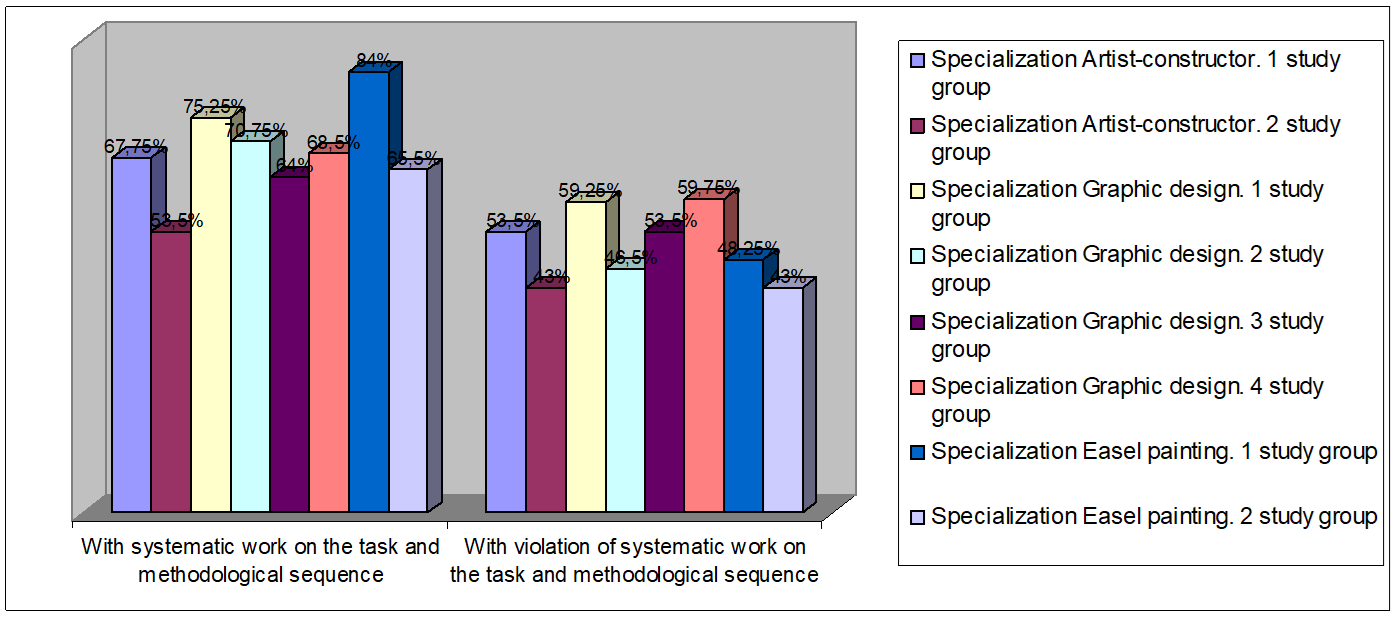
Source: Own elaboration.
Figure 1. Dynamics of the improvement in proficiency with a structured approach to learning
Based on the data presented in the diagram, we can see an increase in the level of achievement in connection with systematic work on creative assignments and methodological consistency of teaching.
In terms of the ascertaining experiment, it was located in the experimental study of the global component It allowed to identify and determine the initial level of training, the level of mastery of the material, psychological characteristics, and some changes in psychological characteristics in the process of exposure and influence of creative tasks on student study groups. There was no restriction in finding and creating the final version of the art and design work when performing the tasks. All participants in the learning process approached consciously and revealed their inner state, their understanding of objects, the subjects in nature.
At the initial stages of the creation of stylized images in students was traced stiffness, lack of logical thinking, the pictorial plane had no integrity. In creative work it was reflected in the form of uneven, sharp lines, tonal spots, which did not interact with each other and thus violated the unity of the artistic transformed object. After systematic and active creative work there was an activation of the logical system, the level of analytical activity increased. Design projects became more collected and more holistic.
Furthermore, during the projects creation, students analyzed each other's work and expressed their opinions. At the end of the learning process, they compared all graphic and pictorial works and independently saw changes in the positive side.
Aiming to implement the curriculum and the assignments, the author considered necessary to identify the initial level of training in students. Therefore, in Figure 2 it is possible to trace the initial level of formation of the skills of mastering artistic and expressive means, stylization techniques and development of artistic thinking.
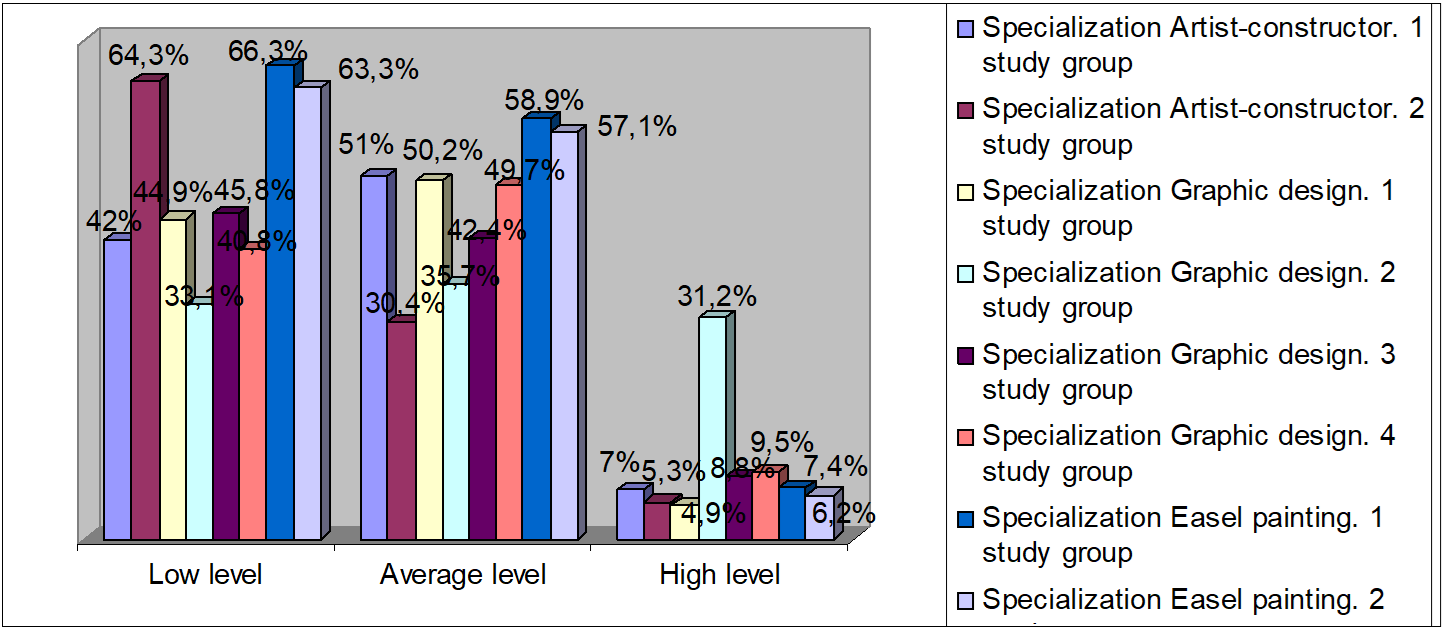
Source: Own elaboration.
Figure 2. Initial level of formation of skills in mastering artistic and expressive means, stylization techniques and development of artistic thinking
According to the data from the chart the main initial level is low. The highest level was represented by the 2nd study group of Graphic Design specialization.
An important method in the study was the developmental method or formative experiment, which was aimed at changing the psychological state and acquiring an understanding of the patterns and principles of various mechanisms of interaction in the world through the active influence of the researcher. There was a systematic activation of thinking in students, thanks to conversations about the compositional structure and accentuated attention, the influence of it on the psychological impact.
The final stage was the control experiment, which proved the effectiveness of the work done in the form of a comparative analysis between the initial and formative stages.
It is necessary to summarize and expand the information about teaching methods.
The emphasis in the teaching methodology is reduced to mastering the planar solution of the spatial environment. Active importance in the learning process is mastering the silhouette rhythmic line, and ornamental filling of the form with some textures based on linear and geometric transformations. The basis can be a certain geometric shape or a complex configuration, which is the foundation for creating a composition, and then plastic knots are built up, which bring a certain dynamics and influence the disclosure of the main idea.
Also, a fundamental layer line can be laid as a basis, which sets the general structure of the configuration and the internal content. Next, a search is made for a rhythmic situation, and with the help of linear interaction, a harmonious and holistic design is created.
We emphasize that the process of teaching academic drawing is based on identifying, comprehending and consolidating knowledge on the basis of volumetric and perspective constructions. One of the important tasks is to find the connection between the subject and the air, which is largely absent when applying the stylization method.
The student's attention is focused on finding the plasticity of forms and their expressiveness.
Of great importance in the development of a stylized object is the choice of format. Experiments are carried out in different formats. The same task is solved in several formats. Thanks to working with different options, at the same time, the student has a sense of balance; an understanding comes of how to convey dynamics or statics with minimal means. The compositional solution in an elongated horizontal rectangle allows you to convey dynamism. In turn, the square is able to reveal statics. With the help of the oval format, we can get closer to the disclosure of tension, the centrifugal effect appears. The vertical format conveys solemnity and grandeur.
Students are looking for the most characteristic form characteristic of a realistic object, and then details are placed in this form, a kind of pattern that contains a semantic load.
The overall shape can be chosen to be static, and the elements within it can be designed to be dynamic.
As a rule, stylization does not solve full-fledged three-dimensional tasks, but students, by combining techniques, create an illusory state of three-dimensionality. In solving these problems, geometric shapes help, which are precisely located in a perspective reduction. Definitely, the mastery of the drawing is of the leading importance in the creative process, and without this mastery the stylization of the object is impossible.
We have highlighted the positive aspects of the method, but we will add that this process contributes a certain value in the development of the need for creative activity, creativity and desire to experiment.
For the implementation of creative plans, various topics are offered: objects of flora and fauna, architecture, people. All topics contribute to the development of a broad outlook and the consolidation of interaction with nature. Also, thanks to the artistic technique, students develop a sense of taste and harmony. A huge positive point is that interest in working to create something new that does not exist before arises in different age groups.
Consider the achievements of students, trace the level of ability and experience to use various artistic and technical techniques to implement their ideas on examples of creative works.
In academic groups an experiment was conducted to actively introduce the stylization method into the learning process, but not to the detriment of the academic disciplines. The students simultaneously worked on both academic realistic assignments and the development and creation of stylized images. The results can be seen in Figures 3; 4; 5; 6; 7; 8 and 9.
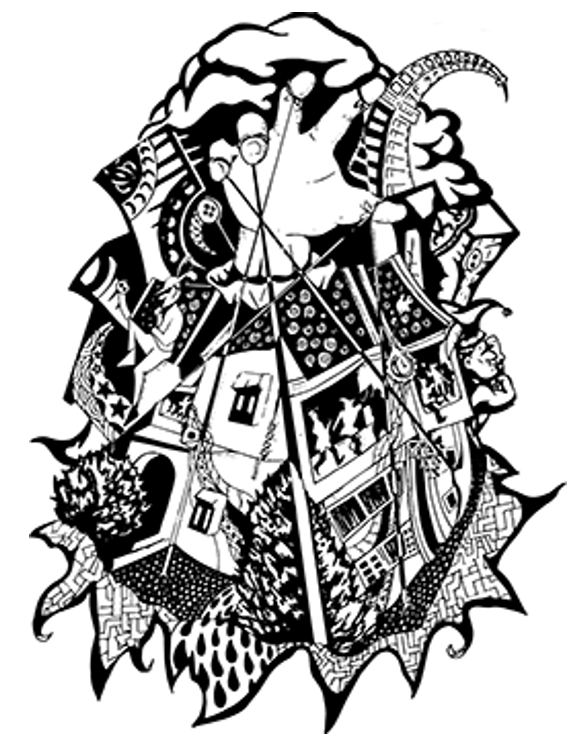
Source: Artwork made by the student of the academic group MP1 specializing in graphic design Andrei Mordonenko, (2023).
Figure 3. Work from the methodological fund. Practical task Stylization and transformation. Puppet show
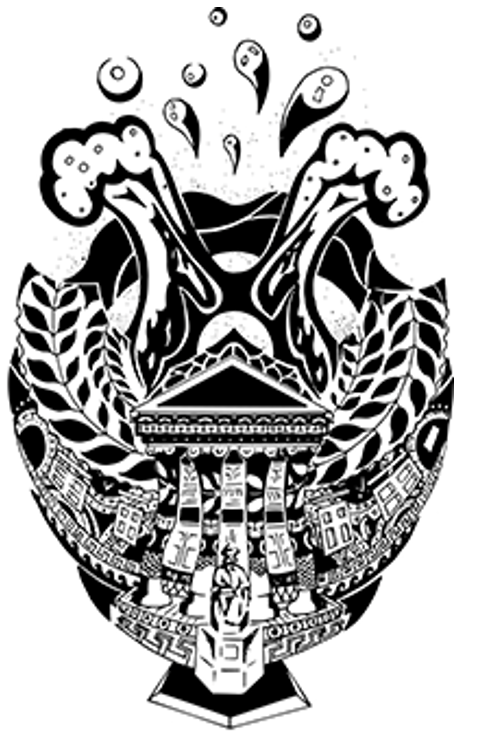
Source: Artwork made by the student of the academic group MP1 specializing in graphic design Andrei Mordonenko, (2023).
Figure 4. Work from the methodological fund. Practical task Stylization and transformation. Hydropathic
Through Figure 3 and Figure 4, the author develops and uses a symbolic-shaped system. He selects the elements that are present in the ideological content of the object and looks for a unified form out of them. The student clearly understands the geometric basis and skillfully uses it, laying down rectangles, squares, triangles, and their combinatory mergers. As a result, there is a unification of all the masses, with one complex configuration, which reveals the essence of the object and the emphasis on the main symbolic sign, which unites all the small elements. Moreover, the use of lines contributes to the interconnection of the image and increases the plasticity of it. The architectural realistic object has moved into a state of figurative language.
The study and experiments with images that go partially beyond the format are actively used. The question is being considered how much it is necessary to cut off the subject in order to reveal the dynamism or static character and get closer to the disclosure of the idea.
One of the main tasks is to form a student's sense of mass and silhouette in the work. He needs to master the expressive means of graphics (point, line, spot).
These decisions contain some of the main differences between the academic approach and stylization. Consequently, the entire realistic image is transformed into a certain sign system. Important at any stage of learning is the disclosure of individual rhythm and the development of the author's approach, style. Geometric and plastic shaping methods are fundamental for image stylization.
Stylization plays an active and effective role in the creation of figurative-semantic, figurative-symbolic works. Thanks to the method, the image begins to contain special effects of artistic expression.
The creation and revival of the spiritual and aesthetic foundations of the personality is a valuable guideline in teaching of students. In this case, art is a link between the subject and spiritual principles. Art and, in particular, every creative project contains experiences, emotions that the author felt when he saw the object and which he put into the author's work. To convey the artistic image and transform the natural object into the work of art, it requires the student to use the analytical and synthetic work of the brain. At the beginning of work, the property, the sign of the object arises, and in the future, the object is divided into details. One of the main conditions for the qualitative creation of the project is a systematic contact with the surrounding reality.
The students in the classroom learn to search for and apply combinatorial approaches and techniques to achieve the desired results. Of course, one of the priority tasks is the development of detail, which contributes to the disclosure of the main idea. Detailing creates a relationship between the elements of the image, reveals the depth of thought. Also, it should be said that the development of the part is based on the figurative beginning. Each detail is endowed with clarity, a certain semantic load.
Each realistic object is studied, analyzed and subsequently displayed as the sketch. The sketch defines the style, techniques with which the specific task will be solved. The smooth transition from the realistic image to a conditionally decorative one contributes to the vision of the expressive features of the form.
The main components in mastering the method of stylization are the form, construction, volume, space and proportions. Analysis of drawings, conversations with students made it possible to characterize the method as an effective way to develop creative and spatial thinking. The result is the formation of the professional personality.
Initially, for practical work and for the formal transformation of the object, not the specific object is proposed, but the general concept of the object or its property. The students are engaged in depicting not the outer contour of the object or the externally perceived feature, but the search for internal content or internal properties.
Creating the main element in the image, which organizes the compositional and optical centers, is important. With the help of the main element, accentuates the idea, reveals the integrity of the artistic image, students pay special attention to this process. They do not leave a lot of empty space in the format to express statics in graphic work and the diagonal is used as the compositional static tool without activating dynamism. The students are constantly searching for the balance of the picture plane.
The surrounding reality is diverse with the large number of different textures. The invoices help to reflect the essence of the depicted, determine its plasticity and convey features. Therefore, the individuals are studying in this direction, they are looking for the transformation of the realistic texture into the ideological decor.
In creative works, the students often use the method of ejecting the element outside the main form, which gives the image dynamics and compositional distribution. One of the main geometric shapes that are used in graphic compositions is a circle, an oval. The additional elements that are layered on the main figure are a triangle, a rhombus. We will not say that only these geometric shapes are used. Depending on the tasks and ideas, the different geometric shapes are used in different quantitative combinatorial ratios.
Furthermore, the drawings show how textures are used to reveal the idea. The author makes extensive use of point and line. The number of dots determines the tonal structure of the entire creative work or the particular element. The number of points allow to create gray and smooth transitions between elements, achieve contrast, and bring out the main thing. The line, which lays the plastic foundation of the object, acquires active significance in creative works. The layer line conveys the foundation of the structure of the object, its inner content.
Using the stylization method in the learning process allows the student to develop artistic and imaginative thinking, activate the imagination and learn to create rather than copy nature. It is important to convey maximum information with minimum means. It is necessary to note the negative aspects of this method – with an excessive passion for conventionality, a less living construction may form, which will not contain the maximum plastic relationship between the elements and thus will not be able to reveal the essence of a realistic object and the author’s idea.
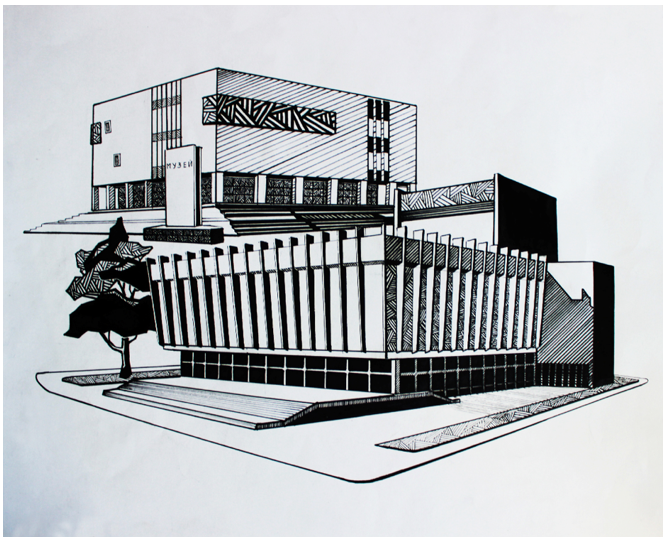
Source: Artwork made by the student of the academic group MP1 specializing in graphic design Karpova Valeriya, (2022).
Figure 5. Work from the methodological fund. Practical task Stylization and transformation. Museum of Local Lore and Academic Russian Drama Theatre
In this creative work, the author solves the problem on the basis of a realistic approach. The student takes a realistic object, generalizes to simple geometric forms and completes the composition with lines and small figures. The rhythmization of forms and tonal spots is found, thanks to which, silhouette, readability of objects and their recognizability are created. The author has clearly defined the number of forms in the paper format, which favorably affects its balance. Moreover, the student, combines two architectural objects, which in the real environment are not located next to each other. Thanks to the geometric language system, the individual creates a coherent work.
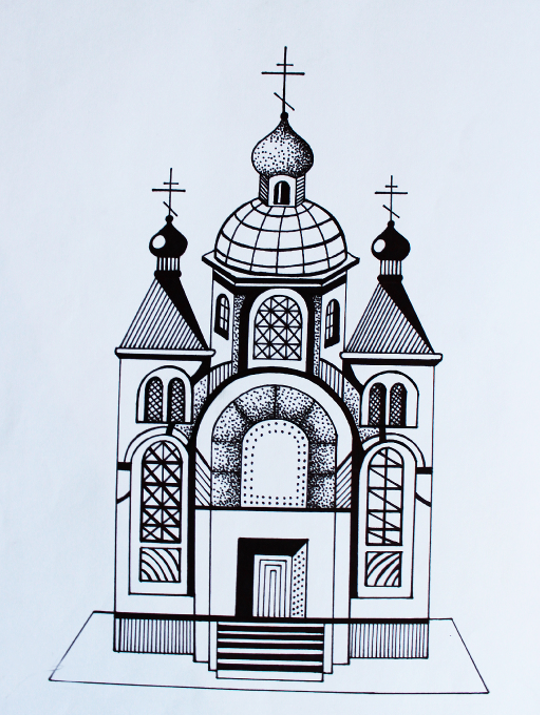
Source: Artwork made by the student of the academic group MP1 specializing in graphic design Tatiana Shapulinskaya, (2021).
Figure 6. Work from the methodological fund. Practical task Stylization and transformation. Church of the Holy Martyr Tatiana
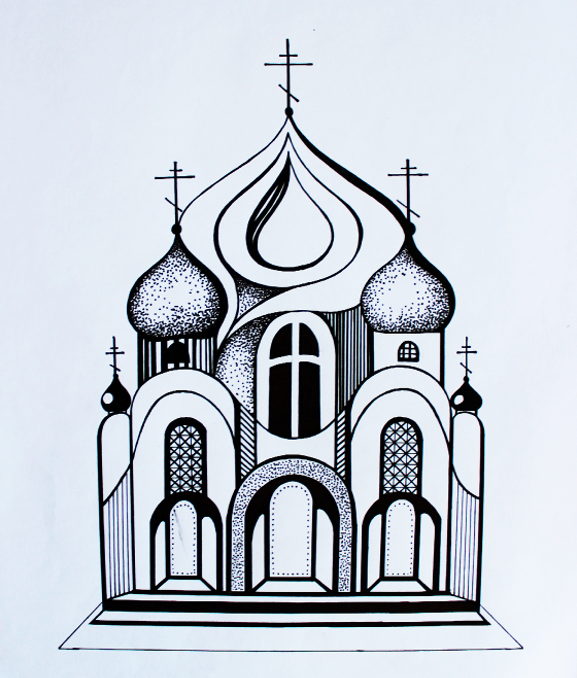
Source: Artwork made by the student of the academic group MP1 specializing in graphic design Tatiana Shapulinskaya, (2021).
Figure 7. Work from the methodological fund. Practical task Stylization and transformation. Spirituality
On the example of Figure 6 and Figure 7 the stylistic unity can be traced. This is also due to the fact that the two creative works were performed by Tatiana Shapulinskaya. The student developed a single stylistic technique, which she applied in the creative works. Geometric figures are the basis, but further the student transforms them by imposing one figure on another, which allows achieving more fluid configurations. This technique creates fluidity, fluidity of the entire image, and displays the main idea. Thanks to the smooth transitions, clearly readable in certain nodes of the image, the emphasis is placed on the disclosure of the role of the object in the surrounding reality. Additionally, the student introduces a smooth line that connects all the elements and enhances the sounding of the main and secondary.
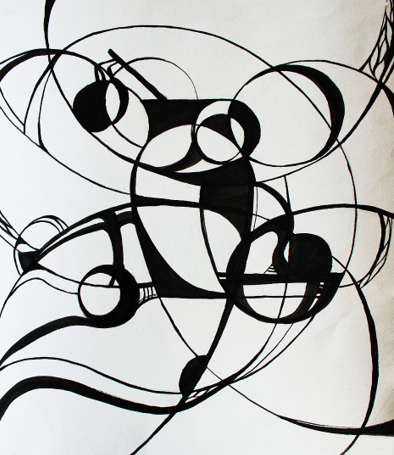
Source: Artwork made by the student of the academic group MP1 specializing in graphic design Anastasia Ruban, (2020).
Figure 8. Work from the methodological fund. Practical task Stylization and transformation. Relationship in rhythms
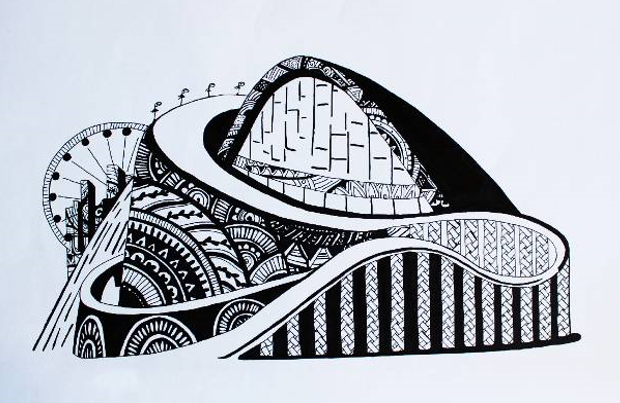
Source: Artwork made by the student of the academic group MP1 specializing in graphic design Evgenia Vyatkina, (2018).
Figure 9. Work from the methodological fund. Practical task Stylization and transformation. Plasticity of the city
According to what it is exposed in Figure 8, the student is searching for the most plastic smooth solution and she achieves this goal through a structured, systematic relationship between the lines by intertwining them, the lines create a definite geometric basis. The composition is created on the basis of circles and ovals. When the lines are intertwined, a block system is formed, which the author fills with a dark tone, emphasizing the attention in certain nodes of the image and strengthening the compositional center.
Evgeniya Vyatkina, who is the author of Figure 9, solves the problem of stylization by superimposing circles of different diameters on each other, the extra parts are cut off and a complex structure is formed. The student enriches the image with small linear and geometric shapes, which create an additional texture and the whole object begins to break into small and large masses. These masses contribute to the disclosure of the main thing in the compositional solution and, of course, reveal the role and belonging of the architectural structure.
The level of improvement in the quality of education, through the use of the method and without using the method in the educational process can be traced in Figure 10.
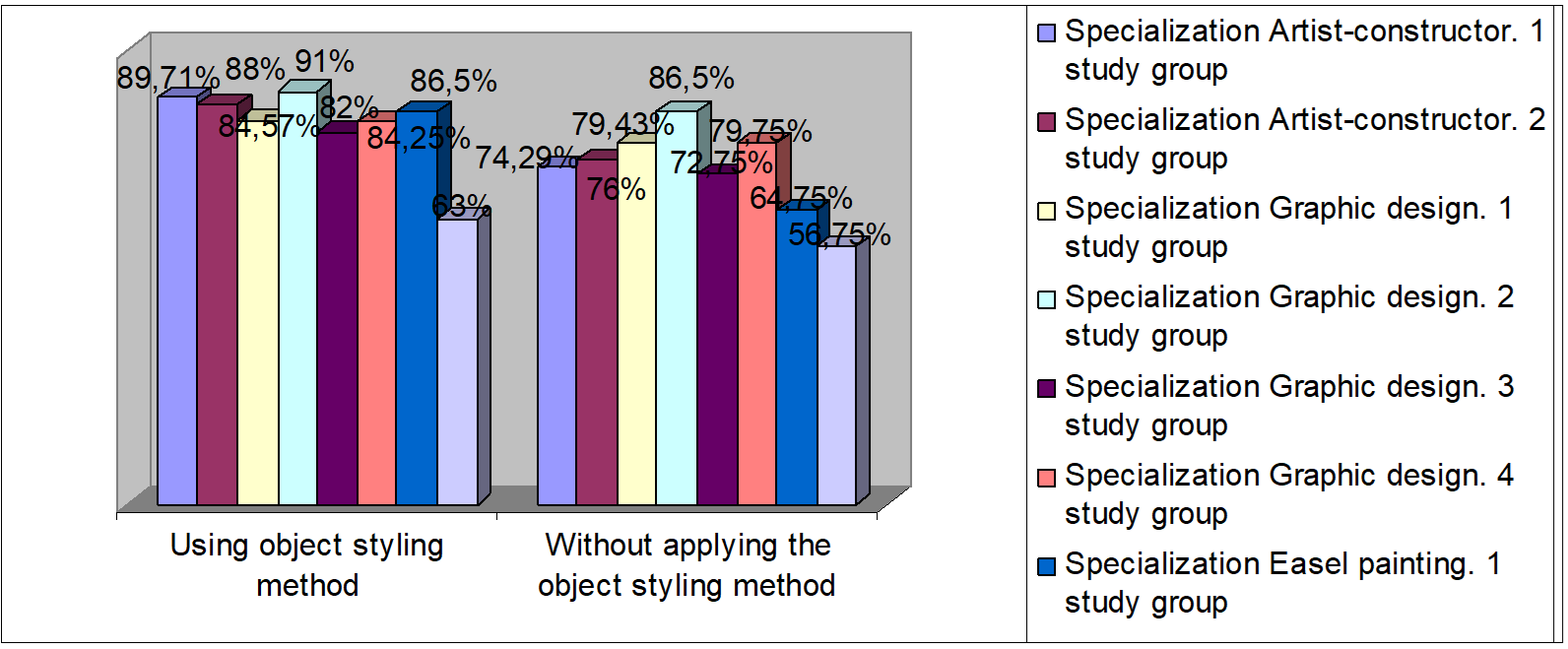
Source: Own elaboration.
Figure 10. Degree of learning with and without the object stylization method in academic groups
From the chart you can see that the scores with and without the method are approaching, but, nevertheless, the dominant approach to learning remains with the stylized approach and leads to the most increased learning.
Analysis and discussions of the results
According to the collected data and information processing, the experiment found that the main shortcomings that harm the learning process and prevent the full formation of imaginative thinking and artistic taste in students is the small number of hours on the tasks of artistic processing of the object. Analyzing the situation, the following percentages were received: 83% for drawing from nature, 7% for drawing from memory and 10% for stylization. It is necessary to pay more attention to this process; studying and drawing from nature should remain a priority. By increasing the number of hours that are focused on creative transformation, better results can be achieved and students can develop their creativity more quickly. Perhaps this process may not affect all specialties and not in equal proportions. Also, the lack of conscious attitude of the student to the learning process negatively affects the quality. It is necessary, to constantly monitor the performance of assignments, to evaluate all stages of creative work.
The results of the experiment showed that the method is effective. After its application the level of intellect, imagination increased, a deep stock of theoretical knowledge appeared. It became easier for students to work and transfer space, to reveal the rhythm. The author's style began to reveal in them, which is not unimportant for the artist, designer. It should be noted that further application and improvement of curricula and assignments allows increasing significantly the professional level of the youth.
To analyze the effectiveness of the methodological system model in the process of pedagogical research, the control stage of the pedagogical experiment with students of 8 study groups was conducted. Individual tasks were given to identify the development of imagination, creative thinking and professional experience. The first task was the analysis of the compositional construction of the artwork with further discussion. The search for the rhythm of vertical and horizontal lines, diagonals, rounded lines, squares, triangles, rectangles, circles was conducted on separate sheets of tracing paper. After finding all the elements of the composition, all the sheets of paper were superimposed one on top of the other. As a result of the fact that the paper is transparent, all schemes were translucent, forming a single structural component. A comparative analysis of the results of the initial stage of development and the control stage was conducted. Analyzing the results, the two experiments were found to increase the level, compared to the first stage, it rose from low to medium level, and some groups reached high levels.
The second assignment consisted of designing an architectural structure using the artistic method. The results were evaluated and discussed. The result was the students working together to create a single project. They developed a map of the city with the created monuments of architecture. As a positive outcome, it stands out the association of many participants of this process, there was an interaction between them, which led to a beneficial result. The individual work turned into a collective activity. With the help of this work, the author checked the theoretical level of students, their possession of composition methods, means of expression and development of figurative and symbolic thinking.
At the end of the practical work there was an assessment of the level of knowledge, skills, and abilities. The creative works were evaluated according to the following criteria.
Methodical consistency in solving creative tasks; choice of motif; compositional placement in the format of a sheet of paper; original structure and novelty in compositional techniques; presence of the main and secondary; choice of perspective; proportional ratios of elements. Artistic expressiveness, which includes: the use of a set of graphic means of expression, identifying geometric forms and finding the relationship between them, the rhythm of tonal masses and lines, a variety of techniques, detailing, revealing the mood and the author's idea, the degree of convention in the stylized transformation, transfer of image and symbolic structure, the ability to emphasize, synthesize and combine, convey the author's style.
Note that the same evaluation criteria were used when selecting student teaching papers for the methodical fund.
The results of the assessment of the quality of knowledge are considered in the Figure 11.
According to the results, there are significant changes compared with the initial results. The bulk of the students received an average score, which was 1.28 times higher than those who received the highest score.
The experiment revealed the students' basic abilities and their ability to solve stylized problems (see Figure 12).
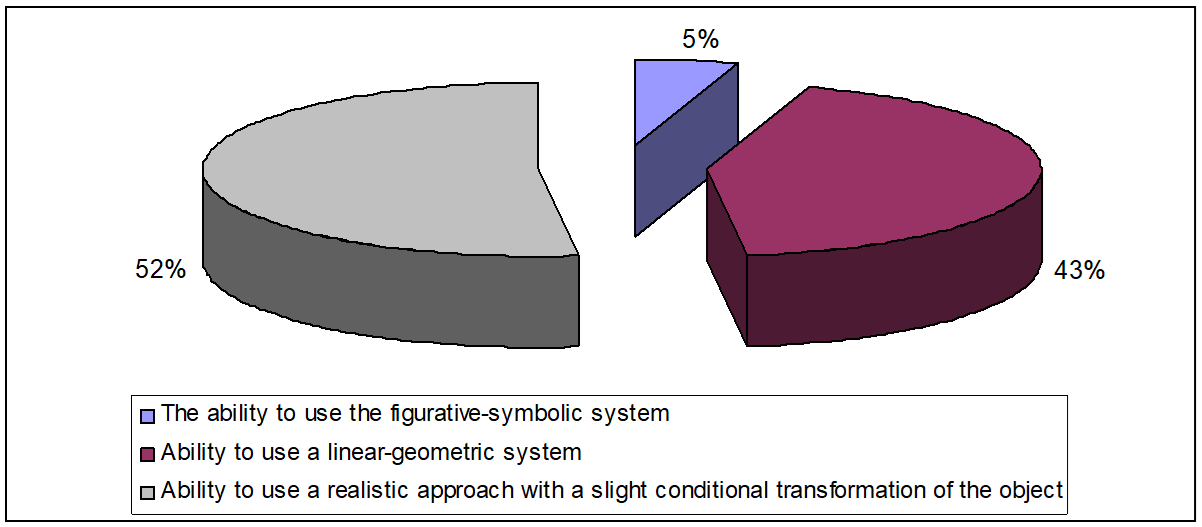
Source: Own elaboration.
Figure 12. Students' ability to choose a creative approach in solving stylistic problems
Most of the student group is able to solve tasks with a less in-depth approach, they create a realistic image with little use of conventionally-shaped solutions. 43% from these individuals under study understand and know about geometric shapes and use them to conventionally transform the object. They also apply the line, which unites all forms and solves plastic problems. Only 5% who set and solve global creative tasks and create a figurative and meaningful image. As a result of constant creative work, the indicators change and the level increases.
The final stage of the study traced the changes in the level of mastery of the artistic method over different time intervals in Figure 13.
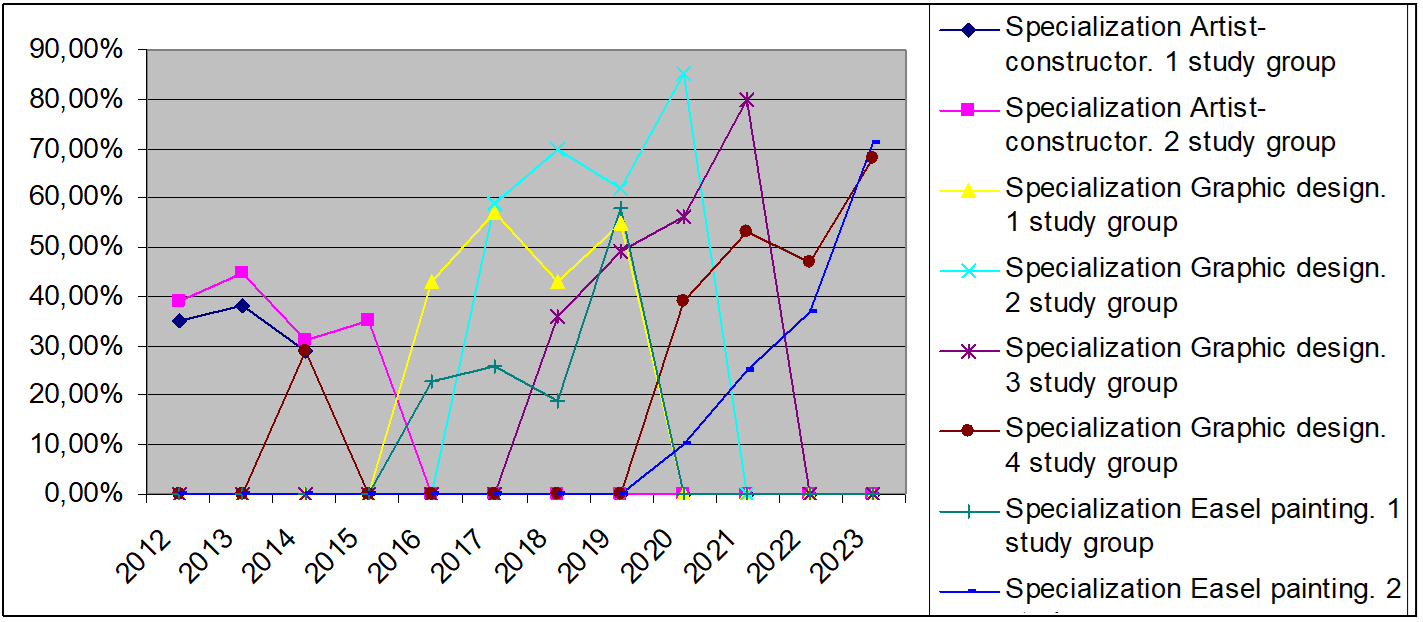
Source: Own elaboration.
Figure 13. Dynamics of development of stylization skills by students in different periods
The results are mixed, but it exists an uptick in 2018, 2020, 2021, and 2023. By comparing the highest indicator of 2012 and 2023, it is possible to see the growth of interest in the creative process. The goals and objectives after the experiment were achieved. The development of the method in the educational process, can improve the quality of education and form the necessary professional qualities to become an artist-designer.
Conclusions
This study was developed on the basis of observations and conducting an experiment in the process of teaching at Luhansk State Academy of Culture and Arts named after Mikhail Matusovsky.
From the study conducted at the educational institution, the investigator concluded that the stylization method is necessary and relevant in the process of artistic and aesthetic education and the formation of professional personality. The method forms figurative thinking and reveals cognitive and emotional qualities. One of the main conditions for achieving a positive result is systematic, structured work on creative assignments and the study of the surrounding reality with detailed analysis. Also, in the process of learning activities, it is necessary to learn mathematical laws and fundamentals, since, on the basis of mathematics and geometry in particular, any object is based. By building the process of breaking down a more complex form into simple components, it will allow you to go deeper into the design features of the object and thereby find in-depth solutions. By mastering the form system of any object formed imagination, memory and laid theoretical knowledge.
According to statistical data, there is a gradual increase in the development of creative abilities of students, as a result of tasks that are associated with the transformation of form. Having analyzed the changes in the indicators of the population under study’s understanding and application of the techniques of creating new forms, for different time intervals, it can be stated that in previous years, the level was lower than in recent years. A smooth dynamics of the processes of development and formation of a person endowed with the thinking of the future appears.
Based on observations and statistics, the figurative-symbolic solution of the project is the most significant, but in terms of percentage takes a small number.
As a result, the artistic method of stylization is one of the most effective means in art and aesthetic education.
RECOMMENDATIONS
Students constantly face a number of problems when creating an artistic or design project, they are in the inability to collect, analyze and organize the information obtained, do not own the technical methods, not developed figurative thinking. First of all, it is necessary to systematically study objects of reality, thereby come to the laws that are embedded in it. In the study of the object should be analyzed, it can start from the structure of formation and go all the way down to the smallest element. Superficial outlines, contours of the object will not give the proper result, the importance of the researcher is manifested in revealing the essence of the internal content, the device. Any subject contains the main nodes by which it is built, so it is important to find these reference points by detailed disassembly and then combine them into a unified system. The student needs to take apart a work of art for structure, to find and draw out the compositional structure. As described above, verticals and horizontals, geometric large and small shapes, spirals of different levels and sizes are searched for, on the basis of which the creative work is created. After the fundamentality of the construction of a painting has been studied, there is an opportunity to develop one's own system of construction and to lay it down in one's project.
The artistic method empowers and teaches people to work on finding a figurative solution. The creator, without feeling the studied material, simply will not be able to convey it on the picture plane, will not lay down his worldview, feelings and emotions. They can be displayed in the form of smooth or rough lines and spots, which will characterize the inner state of the artist. One of the additional tasks that can develop plasticity and figurative thinking is the development of the line as a means of stylization. The result will be an abstract creative work that is designed to show associative structure. Students are presented with melodies and music of different genres and ranges, they are shown reproductions of world artists, watched cartoons and films, and the students try, with one or more lines, to depict what they have heard or watched. The main task in this case remains the disclosure of the figurative-symbolic state, the transfer of recognizability of a particular work. The material may be any: ballpoint pen, felt-tip pens, colored pencils, rulers and combined compounds. The image of an animal or species of trees, using a continuous line, is also effective. Also, an excellent topic activating memory and imaginative understanding can be an optical illusion, in which, through a change of direction, pressure, can manifest a particular image. For the designer, this activity will be the basis of their professional activities. Brand names, logos, pictograms, and printed products are created on the basis of plastic shaping.
















